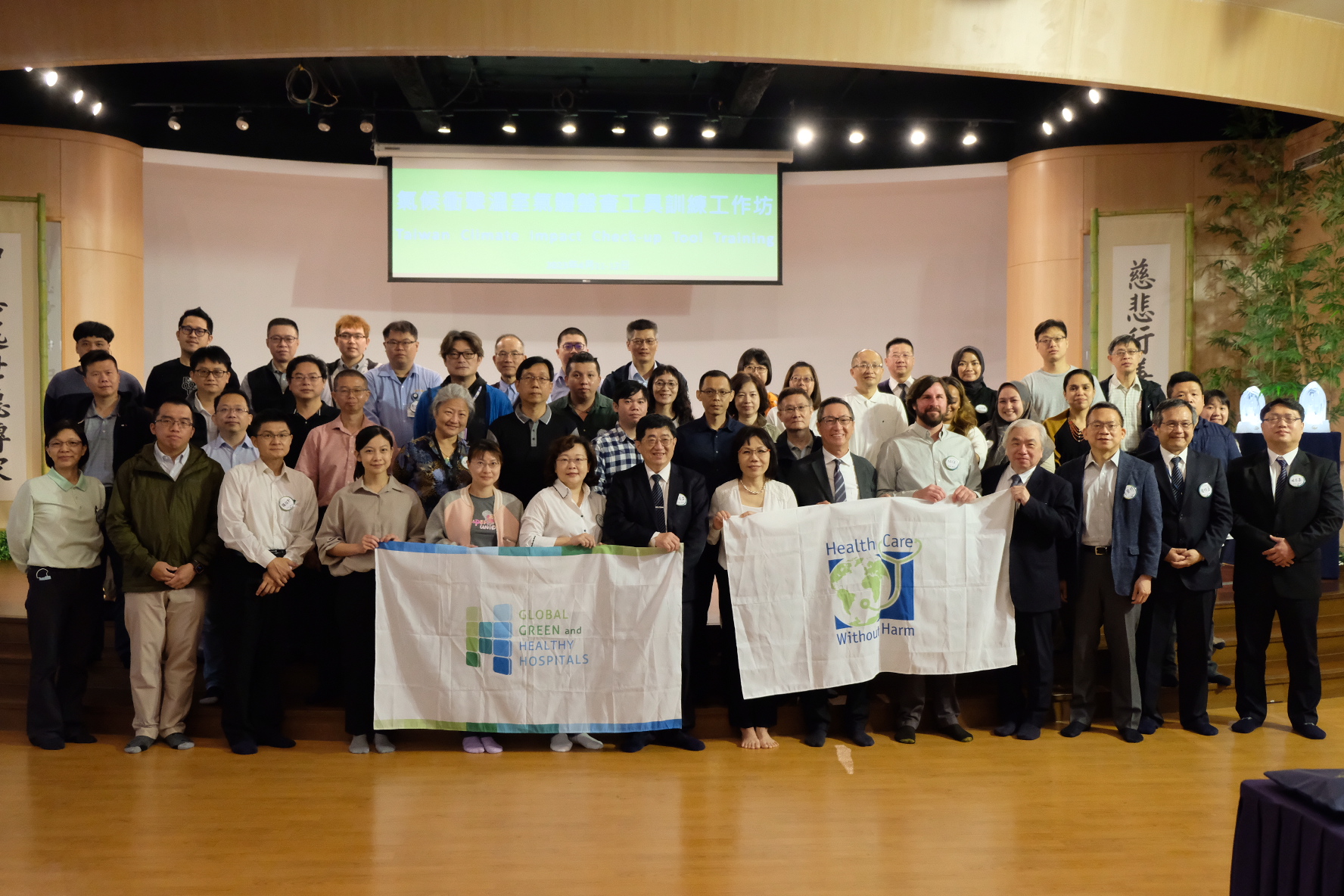Race to Zero by 2050: Interventions in energy, waste, food, and transport
Dalin Tzu Chi Hospital, Taiwan
Case study summary
Our hospital prioritizes both patient care and environmental responsibility. Committed to Global Green and Healthy Hospital's 10 goals, we strive to minimize waste, enhance energy efficiency, and promote community health, ensuring a sustainable future for all.
Demographic information
- City: Chiayi County
- Country: Taiwan
- Type of institution: Private hospital
- Number of full-time staff: 1,800
- Number of part-time staff: 230
- Number of beds: 948
- Patient population served annually
- 960,000 patients served annually (total of inpatient and outpatient)
- Geographic area served: Southern Taiwan, international patients
- Health equity concerns experienced by your population:
- The lack of medical resources in remote mountain areas
- Insufficient public transportation
- Serving the oldest county in Taiwan without comprehensive long-term care services.
The issue
Our hospital's core mission is to enhance patient care, yet we acknowledge climate change as a vital 21st-century health challenge. It impacts health care via demand surges and infrastructure vulnerabilities. We're dedicated to equitable health and eco-friendly practices for patients, staff, and society. Climate change worsens infections, strains resources, and affects staff well-being. Through audits and innovations, we act on sustainability.

Climate change will be the most significant health threats in the 21st century. Enlightened by that, our hospital is dedicated to reducing the environmental impact while treating the patients and promoting the health of the people in the community. We systemically implemented green hospital programs in the hospital and the community. Through the energy monitor system, we could save NTD 4.5 million due to yearly energy efficiency improvement. The training and education for our staff could reduce the waste around the hospital campus. Our ultimate goal is to achieve Net Zero by 2050.
Hospital goal
As Asia's inaugural participant in the Race to Zero Campaign since 2021, we commit to exemplifying eco-friendly health care. Goals include LED lighting by 2025, reviewing scope 1-3 emissions, reducing annual electricity use by 1%, cutting waste per person/bed, enhancing water efficiency by 50%, serving plant-based diets with local produce (95%), and minimizing health care’s carbon footprint.
Sustainable strategy implemented
The strategy embraced a holistic approach, uniting stakeholders and departments to conquer sustainability and climate hurdles. With government funding, our hospital executed an extensive LED replacement project to curb high electricity consumption and cut down on electrical costs. Additionally, we evaluated major equipment's energy use.
To address patient transport challenges, we launched complimentary public transit and train station shuttles, curbing individual emissions. We encouraged cycling with free bikes and shuttle services for patients reliant on public transport.
Additional strategies in plant-based diets promotion and food waste management were also implemented.
The use of GGHH Connect tools aided in tracking and managing emissions data, pinpointing enhancements through regular updates and historical comparisons.

Implementation process
The Health Promoting Hospital (HPH) Committee has led the eco-friendly charge since 2007. The collaboration included the general affairs office, engineer office, and devoted staff, joined by global NGOs like GGHH. The success is derived from top-down and bottom-up dynamics, robust leadership, and staff involvement. Research and health care sustainability case studies informed the strategy, incorporating resource assessment, financial viability, and feasibility. Regular reviews tracked progress, ushering constant improvement.
Training programs instilled waste segregation and eco-consciousness in newcomers. Regular awareness initiatives educated staff, patients, and visitors about environmental impacts. We prompted cultural shifts through posters, displays, and policies that endorse eco-culture, while awards for innovative water, energy, and waste reduction foster eco-friendly practices among staff.
Food-related strategies included education on food waste segregation and further promotion of our plant-based diet in the facility and the community. A plant-based diet can reduce CO₂ emissions by 7 kg daily compared with an animal protein diet. Our successful no-straw campaign discouraged disposable utensils and plastic straws, saving 367,761 straws by 2020.
All strategies underwent assessment and adjustment by the HPH Committee.
Tracking progress
Quarterly meetings assessed budgets and plans with regular achievement reports. Success metrics were defined at the project's outset and tracked via the governmental industrial waste report and management system for waste reduction. The GGHH climate impact checkup tool tracked emissions fostering capacity building. Scope 1, 2, and 3 emissions including combustion, cooling, waste, and more were collected, totaling 9546.49 tCO₂e, with scope 2 as the primary source (80%) in 2021.
Collaborations with GGHH, Health Care Without Harm, and ISO certifications underline our data-driven, global-minded commitment to sustainability and environmental care. The ISO 14064 greenhouse gas accounting and verification project improved inventory and reporting via quantification processes. ISO 50001 energy management systems accreditation optimizes energy efficiency through continual improvement.

Progress achieved
Dalin Tzu Chi Hospital is the lowest energy use intensity regional hospital in Taiwan. Our waste management and energy-saving measures saved NTD 4.5 million (USD 145,000). Collaborative models, staff integration, and continual training can foster eco-conscious hospital spheres. Strategies included installing heat pumps, inverters, saving electricity, and using sensor lighting, leading to 6,018,147 kWh electricity savings annually and curbing 3,971,977 kg CO₂ emissions. A 48.5 kW solar system reduced CO₂ emissions by 72,770 kg.
Monitoring via the intelligent building energy monitoring system by the Industrial Technology Research Institute improved electricity use. NTD 4.5 million (USD 145,000) savings resulted from improved energy efficiency. Public transit initiatives enhance access to health care and while also reducing emissions.
Dr. Ming-Nan Lin represented us at multiple United Nations Framework Convention on Climate Change and Conference of Parties sessions, sharing Tzu Chi's sustainable practices. We co-organized climate impact checkup tool trainings and annual conferences with the Taiwan HPH Society, hosting the 4th Green Hospital Asia Conference in 2017 with more than 400 attendees. Our engagement in the UN Race to Zero Campaign showcased our commitment.
Notable accolades include WHO HPH standards award, climate challenge champion awards, green hospital excellence recognition, and sustainable action awards, affirming our global leadership in environmental sustainability.
Challenges and lessons learned
Health care's significant greenhouse gas emissions pose hurdles. Tackling energy intensity, affordability of renewable energy, supply chain complexities, and infrastructure costs demand focused efforts.
Collaborating with Khoo Teck Puat Hospital in Singapore, we exchange sustainable strategies and inspire initiatives like rooftop farms and plant-based diets. We are also working with Health Care Without Harm and health care partners worldwide.
Taiwan's Greenhouse Gas Reduction and Management Act offers a framework, though health care's compliance isn't mandatory. Dalin Tzu Chi Hospital has taken a lead role in advancing climate strategies preemptively, aligning with environmental protection and national development goals.

Next steps
Despite inherent challenges, Dalin Tzu Chi Hospital is taking steps to achieve decarbonization. We are implementing energy efficiency measures, investing in renewable energy sources, and working with suppliers to reduce emissions throughout the supply chain. There are seven hospitals under Buddhist Tzu Chi Medical Foundation in Taiwan. Dalin Tzu Chi aims to be a pioneer and lead other Tzu Chi Hospitals to achieve the Race to Zero goals.
Links
Links (in Mandarin)
- https://udn.com/news/story/7326/7108367
- https://udn.com/news/story/7266/6977216
- https://www.snq.org.tw/chinese/03_service/02_detail.php?pdid=6516
- https://www.tcnews.com.tw/medicine/item/18318.html
- https://www.tcnews.com.tw/medicine/item/14007.html
- https://dalin.tzuchi-healthcare.org.tw/index.php/zui-xin-xiao-xi/ben-yuan-gong-gao-3/cong-ge-ren-dao-de-qiu-jian-kang-lian-he-guo-yi-yuan-dai-biao-can-fang-da-lin-ci-yuan
- https://taiwanreports.com/archives/692890
- https://www.tcnews.com.tw/medicine/item/18265.html
- https://www.tcnews.com.tw/medicine/item/18239.html